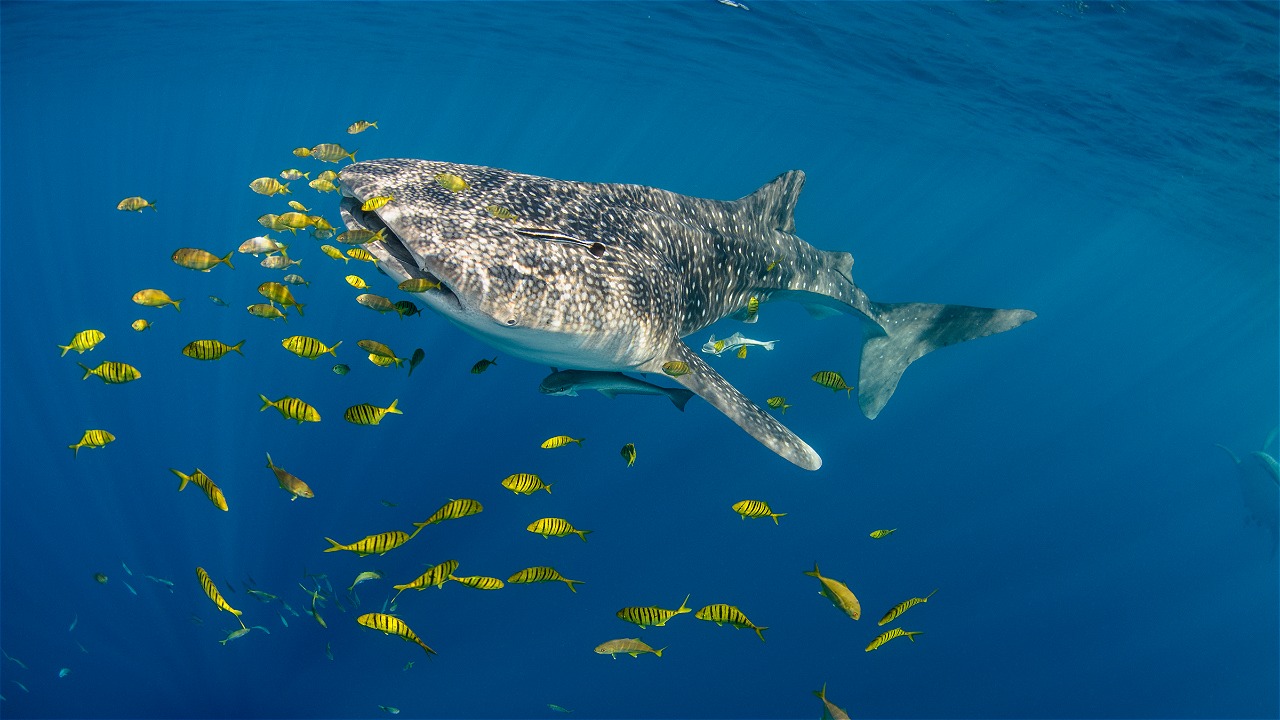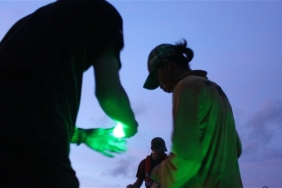WWF STARTS WHALE SHARK MONITORING AND RESEARCH PROGRAM IN “TELUK CENDRAWASIH”
By: Masayu Yulien Vinanda and Creusa Hitipeuw
Nabire (10/05)-In the eastern part of Indonesian waters, particularly in Teluk Cendrawasih Marine National Park, West Papua, a group of giant fish, whale shark (Rhincodon typus) often sighted on the sea surface. The consistent sightings of whale shark in Cendrawasih Bay and other areas in the Bird’s Head, Papua has associated with the presence of lift net (Bagan) fisheries that target anchovies.
Whale sharks are apparently attracted to these nets by the concentration of small fishes in these nets and consequently the sharks can be easily observed and closely approached there. This finding encouraged WWF Indonesia to start establishing a monitoring network for whale sharks in the Bird’s Head area of Papua to assess their spatial and temporal distribution and evaluate potential threats and to develop ecotourism as part of the management of Cendrawasih Bay Marine Prorected Are. This work involves capacity building for whale shark conservation and management related research techniques for local conservation partners (NGOs, university, park authority and dive operators)
In partnership with Teluk Cendrawasih National Park Authority and Papua-Pro (ecotourism operator), WWF-Indonesia organized a training workshop for monitoring and research methods for whale shark conservation and potential ecotourism development in Nabire, starting from 2-7 May 2011. A number of key stakeholders including local government agencies, National Park Authority, local universities, and community representatives participated in the 4-day training workshop.
The training session was taught by Dr. Brent Steward, a senior research biologist from Hubbs-SeaWorld Research Institute, San Diego, USA. Participants learned about basic bio-ecology of whale sharks and the use of photo identification and telemetry techniques to study the behavior and movement as well as to monitor the population. Practice of whale shark eco-tourisms in Western Australia, Philippines, Kenya, and Maldives were also shared during the classroom session including code of conducts for tourist’s interaction with whale sharks.
“Field exercise on the use of underwater digital camera for photo identification and deployment of transmitters took place in the National Park area, around the village of Kwatisore.
A satellite-linked tag was successfully deployed on a male, sub adult, whale shark. The tag will record data on the light level, temperature and water depth that can be used to identify the behavior and critical habitats as well as potential threats the species may face. This information is essential for developing necessary management action including regulations and ecotourism venture to protect the largest fish on the planet.
“Mostly I just free dive, aproach the shark, get close enough that I would feel comfortable that it will be a good attachment, and then I use a small spear gun to hook the tip of the transmitter through the fat layer under the shark’s skin .. and we can control how deep that tip goes..and keep that tip within. Probably about 4cm or less deep below the skin. That is how we keep the tag attached,” Brent said.
Tag is inserted in the dorsal fin that has more muscles, so the tagging won’t hurt or harm the shark. The tag will be automatically detached after 6 months and will transmit the stored data through satellite.
Brent was amazed that interaction with whale sharks in Cendrawasih Bay was much easier than other sites he visited. In Teluk Cendrawasih, the sharks regularly come out on the sea surface for feeding and don’t seem to get “distracted” by people who are excited to get close to them.
“It’s been a very effective and efficient field work in the last two days. The first day we arrived, we saw one shark right away and then we tagged. It was very quick.and then we saw another ones. And yesterday we came out in one bagan, there were at least 5 or maybe 7, and they were there. We interacted with them for 4 to 5 hours. So, we have a lot of opportunity to observe them. We could have tagged more very easily here. It’s very efficient,” he added.
Training participants were taking hundreds of photos of specific area around the dorsal fin of the shark that has unique, distinctive pattern of light pigmented spots, which have proved to be effective in differentiating individual shark. Photos of these spots taken of the same distinctive area of the body can via a computer program be used as finger-prints – and supplemented with photos of distinctive scars and injuries to fins or body parts of the animals to make identification even more reliable.
In addition to getting knowledge on whale sharks, the multi stakeholder-workshop is expected to gather ideas and generate commitments among the key stakeholders in protecting and managing the whale sharks in the marine conservation area.
“As the workshop finished, I expect there will be a joint commitment to develop and agree on a whale shark monitoring guideline and code of conduct for Whale shark tourism interaction. A synergy of actions by government, private sector, community, and NGOs is essential to sustainably manage the whale shark population and their habitats as both biodiversity and economic assets,” said Project Leader WWF-Indonesia Proyek TNTC, Beny Ahadian Noor.
He is also optimistic that the unique characteristic of whale sharks in Teluk Cendrawasih National Park, the largest marine protected area in Indonesia, will provide unique opportunity for development of whale shark research and community based eco-tourism.





